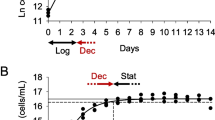Abstract
The absence of dietary sterols and polyunsaturated fatty acids (PUFAs) has been shown to affect the performance of the freshwater herbivore Daphnia. Here, we compared somatic growth rates and clutch sizes of Daphnia magna reared on a diet of low food quality (Synechococcus elongatus) and of high food quality (Cryptomonas sp.) and investigated if and to what extent the absence of sterols or PUFAs in the cyanobacterium S. elongatus accounts for the observed differences in food quality. The supplementation of S. elongatus with cell-free lipid extracts (fatty acids, sterols, total lipids) obtained from the flagellate Cryptomonas sp. suggested that the superior food quality of Cryptomonas sp. is predominantly, but not completely, a combined effect of its sterol and PUFA composition. Our laboratory study suggests that somatic growth of D. magna feeding on S. elongatus is primarily constrained by the absence of sterols, whereas egg production is primarily limited by the absence of long chain PUFAs.

Similar content being viewed by others
References
Becker C, Boersma M (2005) Differential effects of phosphorus and fatty acids on Daphnia magna growth and reproduction. Limnol Oceanogr 50:388–397
Carpenter SR, Cole JJ, Hodgson JR, Kitchell JF, Pace ML, Bade D, Cottingham KL, Essington TE, Houser JN, Schindler DE (2001) Trophic cascades, nutrients, and lake productivity: whole-lake experiments. Ecol Monogr 71:163–186
DeMott WR, Edington JR, Tessier AJ (2004) Testing zooplankton food limitation across gradients of depth and productivity in small stratified lakes. Limnol Oceanogr 49:1408–1416
Gladu PK, Patterson GW, Wikfors GH, Chitwood DJ, Lusby WR (1990) The occurrence of brassicasterol and epibrassicasterol in the chromophycota. Comp Biochem Physiol B 97:491–494. doi:10.1016/0305-0491(90)90149-N
Gladyshev MI, Sushchik NN, Dubovskaya OP, Makhutova ON, Kalachova GS (2006) Influence of sestonic elemental and essential fatty acid contents in a eutrophic reservoir in Siberia on population growth of Daphnia (longispina group). J Plankton Res 28:907–917. doi:10.1093/plankt/fbl028
Gladyshev MI, Sushchik NN, Dubovskaya OP, Makhutova ON, Kalachova GS (2008) Growth rate of Daphnia feeding on seston in a Siberian reservoir: the role of essential fatty acid. Aquat Ecol 42:617–627. doi:10.1007/s10452-007-9146-7
Goad LJ (1981) Sterol biosynthesis and metabolism in marine invertebrates. Pure Appl Chem 51:837–852. doi:10.1351/pac198153040837
Grieneisen ML (1994) Recent advances in our knowledge of ecdysteroid biosynthesis in insects and crustaceans. Insect Biochem Mol Biol 24:115–132. doi:10.1016/0965-1748(94)90078-7
Guillard RR (1975) Cultures of phytoplankton for feeding of marine invertebrates. In: Smith WL, Chanley MH (eds) Culture of marine invertebrate animals. Plenum Press, New York, pp 26–60
Harrison KE (1990) The role of nutrition in maturation, reproduction and embryonic development of decapod crustaceans: a review. J Shellfish Res 9:1–28
Jüttner F, Leonhardt J, Möhren S (1983) Environmental factors affecting the formation of mesityloxid, dimethylallylic alcohol and other volatile compounds excreted by Anabaena cylindrica. J Gen Microbiol 129:407–412
Lampert W (1991) The dynamics of Daphnia in a shallow lake. Verh Int Verein Limnol 24:795–798
Leibold MA (1989) Resource edibility and the effects of predators and productivity on the outcome of trophic interactions. Am Nat 134:922–949. doi:10.1086/285022
Martin-Creuzburg D, von Elert E (2004) Impact of 10 dietary sterols on growth and reproduction of Daphnia galeata. J Chem Ecol 30:483–500. doi:10.1023/B:JOEC.0000018624.94689.95
Martin-Creuzburg D, Wacker A, von Elert E (2005a) Life history consequences of sterol availability in the aquatic keystone species Daphnia. Oecologia 144:362–372. doi:10.1007/s00442-005-0090-8
Martin-Creuzburg D, Bec A, von Elert E (2005b) Trophic upgrading of picocyanobacterial carbon by ciliates for nutrition of Daphnia magna. Aquat Microb Ecol 41:271–280. doi:10.3354/ame041271
Martin-Creuzburg D, Westerlund SA, Hoffmann KH (2007) Ecdysteroid levels in Daphnia magna during a molt cycle: determination by radioimmunoassay (RIA) and liquid chromatography–mass spectrometry (LC–MS). Gen Comp Endocrinol 151:66–71. doi:10.1016/j.ygcen.2006.11.015
Martin-Creuzburg D, von Elert E, Hoffmann KH (2008) Nutritional constraints at the cyanobacteria—Daphnia magna interface: the role of sterols. Limnol Oceanogr 53:456–468
Müller-Navarra DC (1995) Evidence that a highly unsaturated fatty acid limits Daphnia growth in nature. Arch Hydrobiol 132:297–307
Müller-Navarra DC, Brett M, Liston AM, Goldman CR (2000) A highly unsaturated fatty acid predicts carbon transfer between primary producers and consumers. Nature 403:74–77. doi:10.1038/47469
Ravet JL, Brett MT, Müller-Navarra DC (2003) A test of the role of polyunsaturated fatty acids in phytoplankton food quality for Daphnia using liposome supplementation. Limnol Oceanogr 48:1938–1947
Stanley D (2006) Prostaglandins and other eicosanoids in insects: biological significance. Annu Rev Entomol 51:25–44. doi:10.1146/annurev.ento.51.110104.151021
Sterner RW, Elser JJ (2002) Ecological stoichiometry: the biology of elements from molecules to the biosphere. Princeton University Press, Princeton
Von Elert E (2002) Determination of limiting polyunsaturated fatty acids in Daphnia galeata using a new method to enrich food algae with single fatty acids. Limnol Oceanogr 47:1764–1773
Von Elert E, Wolffrom T (2001) Supplementation of cyanobacterial food with polyunsaturated fatty acids does not improve growth of Daphnia. Limnol Oceanogr 46:1552–1558
Von Elert E, Martin-Creuzburg D, Le Coz JR (2003) Absence of sterols constrains carbon transfer between cyanobacteria and a freshwater herbivore (Daphnia galeata). Proc R Soc Lond B Biol Sci 270:1209–1214. doi:10.1098/rspb.2003.2357
Wacker A, Martin-Creuzburg D (2007) Allocation of essential lipids in Daphnia magna during exposure to poor food quality. Funct Ecol 21:738–747. doi:10.1111/j.1365-2435.2007.01274.x
Wacker A, von Elert E (2001) Polyunsaturated fatty acids: evidence for non-substitutable biochemical resources in Daphnia galeata. Ecology 82:2507–2520
Weers PMM, Gulati RD (1997) Effects of the addition of polyunsaturated fatty acids to the diet on the growth and fecundity of Daphnia galeata. Freshw Biol 38:721–729. doi:10.1046/j.1365-2427.1997.00237.x
Wilson AE, Sarnelle O, Tillmanns AR (2006) Effects of cyanobacterial toxicity and morphology on the population growth of freshwater zooplankton: meta-analyses of laboratory experiments. Limnol Oceanogr 51:1915–1924
Acknowledgments
We thank P. Merkel for excellent technical assistance. This work was supported by the German Research Foundation (DFG, EI 179/4-2).
Author information
Authors and Affiliations
Corresponding author
Rights and permissions
About this article
Cite this article
Martin-Creuzburg, D., von Elert, E. Good food versus bad food: the role of sterols and polyunsaturated fatty acids in determining growth and reproduction of Daphnia magna . Aquat Ecol 43, 943–950 (2009). https://doi.org/10.1007/s10452-009-9239-6
Received:
Accepted:
Published:
Issue Date:
DOI: https://doi.org/10.1007/s10452-009-9239-6




